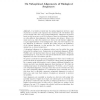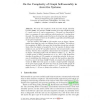36 search results - page 4 / 8 » An Extremal Problem on Degree Sequences of Graphs |
ECCC
2000
13 years 7 months ago
2000
Abstract. We suggest a candidate one-way function using combinatorial constructs such as expander graphs. These graphs are used to determine a sequence of small overlapping subsets...
PATAT
2000
Springer
13 years 11 months ago
2000
Springer
The timetabling problem consists in fixing a sequence of meetings between teachers and students in a given period of time, satisfying a set of different constraints. There are a nu...
ICS
2010
Tsinghua U.
14 years 5 months ago
2010
Tsinghua U.
: We initiate the study of local, sublinear time algorithms for finding vertices with extreme topological properties -- such as high degree or clustering coefficient -- in large so...
CPM
1993
Springer
13 years 11 months ago
1993
Springer
It is widely accepted that the optimal alignment between a pair of proteins or nucleic acid sequences that minimizes the edit distance may not necessarily re
ect the correct biolog...
DNA
2006
Springer
13 years 11 months ago
2006
Springer
We study the complexity of the Accretive Graph Assembly Problem (AGAP). An instance of AGAP consists of an edge-weighted graph G, a seed vertex in G, and a temperature . The goal i...


